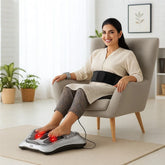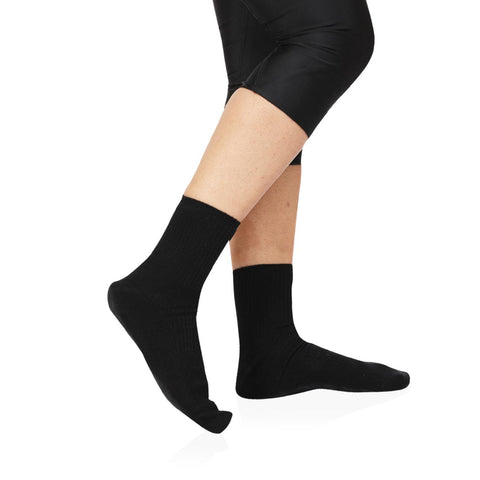What type of socks are best for diabetics?
Introduction :
Welcome to our latest blog post titled "What Type of Socks Are Best for Diabetics?" Living with diabetes requires careful attention to your health, including the seemingly small choices that can have a big impact on your well-being. One such choice is the type of socks you wear. While it might seem trivial, the right pair of socks can significantly enhance comfort, prevent complications, and improve the quality of life for those managing diabetes.
In this post, we delve into the world of diabetic socks, designed specifically to meet the unique needs of individuals with diabetes. We'll explore why standard socks may not be suitable and highlight the key features that set diabetic socks apart. From non-elastic bindings that promote circulation to moisture-wicking materials that keep feet dry, we cover everything you need to know to make an informed decision about the best socks for your diabetic care routine.
Whether you're newly diagnosed, a seasoned pro at managing your diabetes, or shopping for a loved one, understanding the importance of proper foot care is crucial. So, lace up your shoes (over your new diabetic socks, of course), and let's dive into how something as simple as changing your socks can contribute to better diabetic health and comfort.
So, What type of socks are best for diabetics?
The best type of socks for diabetics are those that offer protection, comfort, and support while addressing the specific needs associated with diabetes, such as poor circulation, sensitivity, and the risk of foot ulcers. Here are the key features to look for in diabetic socks:
-
Non-Constricting Fit: They should have a non-elastic binding to prevent constriction, which can impair circulation. This ensures better blood flow to the feet and legs, which is crucial for diabetics.
-
Moisture-Wicking Fabric: Look for socks made from materials that wick moisture away from the skin to keep feet dry. Dry feet are less prone to infections, which diabetics are more susceptible to.
-
Seamless Design: Diabetic socks often have minimal or no seams to reduce the risk of rubbing and blisters, which can lead to foot ulcers in people with diabetes-related neuropathy.
-
Padding and Cushioning: Extra cushioning in areas of the foot that are prone to pressure points can help prevent injuries. This is especially important for those with neuropathy or decreased sensation in their feet.
-
Warmth: Diabetes can affect blood circulation, making it harder to keep feet warm. Socks that provide good insulation can help keep feet warm, especially in colder climates.
-
Antimicrobial Properties: Some diabetic socks are treated with antimicrobial agents to reduce the risk of fungal and bacterial infections.
-
Breathability: Breathable fabrics help maintain a stable temperature around the feet, reducing the risk of fungal infections and keeping feet comfortable.
-
Specific Needs: There are various types of diabetic socks catering to different needs, such as socks with copper or silver threading for their antimicrobial properties, low or high cuts depending on the area needing protection, and socks designed for maximum warmth or breathability.
It's important for individuals with diabetes to choose socks that best meet their specific health needs. Consulting with a healthcare provider for personalized advice is also a good practice to ensure that your choice of diabetic socks effectively supports your health management plan.
Do diabetic socks really work?
Yes, diabetic socks do work in the sense that they are specifically designed to address the needs and risks associated with diabetes, particularly for those with neuropathy (nerve damage), poor circulation, and a heightened risk of skin breakdown and infection. Here's how diabetic socks can make a difference:
-
Improved Circulation: Diabetic socks are non-constricting with a loose fit around the ankles and legs, which can help improve blood flow. This is crucial for diabetics, as poor circulation can lead to complications.
-
Moisture Management: They often feature moisture-wicking fabrics that keep the feet dry, reducing the risk of fungal infections. This is particularly important for individuals whose feet may sweat more, creating a moist environment conducive to infections.
-
Minimize Foot Injuries: With extra padding and cushioning in areas prone to pressure and injury, diabetic socks can help prevent ulcers, blisters, and sores. This is especially beneficial for people with neuropathy who may not feel minor injuries.
-
Prevent Bacterial and Fungal Growth: Some diabetic socks are treated with antimicrobial properties to further reduce the risk of infections.
-
Seamless Design: The seamless or minimal-seam design of diabetic socks prevents rubbing and irritation, which can lead to skin breakdown in sensitive individuals.
While diabetic socks offer several benefits and can help prevent complications associated with diabetes, it's important to note that they are just one part of a comprehensive foot care strategy for diabetics. Regular inspection of the feet, maintaining good glycemic control, and consulting healthcare professionals for foot care management are also vital components of diabetes management. Additionally, not every person with diabetes may need diabetic socks; their use should be based on individual needs, symptoms, and recommendations from healthcare providers.
What is the difference between diabetic socks and regular socks?
Diabetic socks and regular socks differ significantly in their design, purpose, and benefits, especially for individuals with diabetes or those with foot sensitivities. Here are the key differences:
Design and Purpose
-
Diabetic Socks: They are specifically designed to minimize foot injuries and keep feet dry, warm, and protected. Diabetic socks offer features such as non-binding tops to improve blood circulation, moisture-wicking fabric to keep feet dry and reduce the risk of fungal infections, and minimal or no seams to decrease the risk of rubbing and blisters.
-
Regular Socks: Regular socks are designed for the general population without specific health considerations in mind. They might have tighter elastic bands at the top, which can restrict circulation, and seams that can irritate the skin or cause blisters.
Features
-
Non-Binding Tops: Diabetic socks often have loose, non-elasticated tops to prevent constriction, promoting better blood flow to the legs and feet. Regular socks may have tighter elastic that can hinder circulation.
-
Moisture-Wicking Materials: Diabetic socks are made from materials that manage moisture effectively to keep feet dry, reducing the risk of infection. Regular socks might not offer the same level of moisture management.
-
Padding and Cushioning: Diabetic socks sometimes have extra padding in the soles to protect sensitive areas under the feet, reducing impact and injury risk. This feature is less common in regular socks.
-
Seamless or Minimal Seams: The seamless design of diabetic socks helps prevent rubbing and blisters, which is particularly important for those with neuropathy or sensitive feet. Regular socks often have prominent seams that can cause irritation or injuries.
-
Antimicrobial Properties: Some diabetic socks are treated with antimicrobial agents to prevent the growth of bacteria and fungi, reducing the risk of infections. This is not a common feature in regular socks.
Overall, the choice between diabetic socks and regular socks depends on individual health needs. Diabetic socks offer specialized features to address the foot care requirements of individuals with diabetes, providing extra protection to help prevent complications associated with diabetes-related foot issues. Regular socks may be suitable for those without specific foot care needs, but they do not offer the same level of protection or comfort for those at risk of foot problems.
Conclusion on Do diabetic socks really work:
While diabetic socks are not a cure-all and should be considered as part of a broader diabetes management and foot care strategy, their targeted features can provide significant benefits. They work by addressing the specific risks and needs associated with diabetic foot care, making them a worthwhile investment for many individuals managing diabetes. It is also important to consult healthcare professionals for personalized advice, as they can provide recommendations based on an individual's specific health status and needs. Overall, when used appropriately, diabetic socks can be an effective tool in the prevention of diabetic foot complications, enhancing the comfort and quality of life for those with diabetes.











